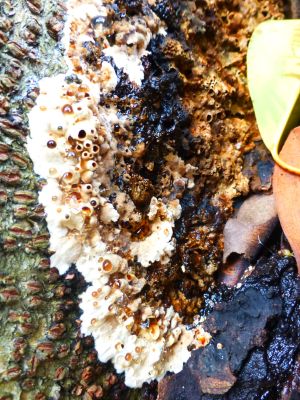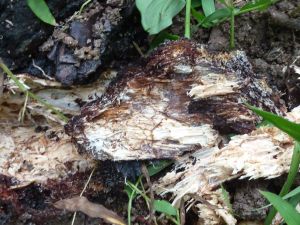|
Trees, like other living organisms have a natural cycle. They grow, age, become weak and eventually pass away. Just like human communities, trees are constantly facing threats of infectious diseases, which, if not handled properly, may result in infection to the entire tree group. This will not only cause further loss of trees but may also pose great threats to public safety.
The Brown Root Rot (BRR) disease is one of the tree infectious diseases that are of great concern to tree work personnel worldwide. This disease is caused by a highly pathogenic and infectious fungus called Phellinus noxius (P. noxius). An infected tree may die within a short period of time, and its surrounding trees can also be easily infected through various modes of transmission, including root-to-root contact, soil contamination, and the dissemination of spores. P. noxius attacks healthy trees and causes tree decay, which will adversely affect the tree structure and damage tree roots. The infected trees will fail to absorb water and nutrients in a normal way and die eventually. Although there are various methods to treat the BRR disease worldwide, there is currently no effective cure for the disease. To prevent the spread of the disease effectively, the global consensus is to remove the infected trees as soon as possible, and carry out proper treatment for the infected soil and the remaining root system to avoid further transmission of the disease and extensive tree infection.
The Greening, Landscape and Tree Management Section (GLTMS) has been working closely with tree management departments to treat BRR infected trees. After consultation with the Expert Panel on Tree Management (EPTM) and making reference to topical literature from Europe, the United States and Taiwan, we promulgated a set of practical guidelines on treating the BRR disease in late 2012 for the reference of departments and the public. Proper training courses and handbooks were also provided for staff of the tree management departments.
We are currently adopting a multi-pronged approach combining preventive and control tactics to safeguard tree health by minimising the sources of fungus. In the past few years, we have collaborated with microbiologists from local universities to conduct fungal surveys, diagnosis of the BRR disease and preventive studies, including the employment of antagonistic fungal species (Trichoderma strains) as biological agent to control the disease. The research team has exchanged views with overseas tree fungus experts to enhance our understanding of the BRR disease. We have also listened to the views of the EPTM in the process.
Although we have taken various measures to prevent the spread of the BRR disease, there are still some trees with confirmed infection, including 18 Old and Valuable Trees (OVTs). It has been our practice to consult the EPTM first on any proposed removal of the OVTs. In non-emergency situations, we will arrange on-site inspections by EPTM members before the removal of trees. In fact, our approach to these 18 infected trees is no different from the past. At a meeting of the EPTM held on 18 April this year, the GLTMS consulted the EPTM members on the proposed removal of 16 infected OVTs (which has been increased by 2 to 18 recently). The members agreed with the proposal in principle, but reminded the GLTMS and the relevant departments that publicity efforts should be carried out properly before the removal. After the meeting, we asked the relevant departments to submit a preliminary plan outlining the resources and time needed for the removal of the infected trees, so that we could provide the EPTM with more detailed information for consideration and for our further discussion. However, I must emphasise that this does not mean that we have now decided to remove all the 18 OVTs. We do not have a precise timetable for the removal, nor do we have any intention of bypassing the usual practice of prior consultation with the EPTM. We feel somewhat puzzled and find it incomprehensible that misunderstanding has arisen in the process.
We want the public to understand that for any trees infected with the BRR fungus, as the damaged parts on the tree trunks can never recover, these trees will always have a higher risk of structural failure. We noticed that the community has doubted whether BRR infected trees should be removed. Some even claimed that the BRR disease could be cured by spraying pesticides among other methods. I must emphasise that based on our knowledge and experience of the disease, while chemical treatment can provide temporary relief to BRR infection, it is not a remedy and cannot restore the long-term health and structural stability of the trees. Even if the symptoms seem to have disappeared and the tree condition appears to have improved, the pathogens inside will continue to cause the trees to decay, making it even more difficult to detect the latent hazards. The fungi hidden in the trunks will then spread the disease to other trees. Therefore, even in these days, the international community generally agrees that the most effective way to prevent the BRR disease is to remove the infected trees as soon as possible, and carry out proper treatment for the infected soil and decayed root tissues.
We cherish trees as much as the public do, and we particularly have strong emotional attachment to those old trees growing together with the community. Nevertheless, I hope the public understand that we, as the policy bureau for tree management, are also responsible for protecting public safety. It has never been easy for the tree management departments to make proposals to remove the infected OVTs with very poor health and structure. Each decision was made painfully after repeated inspections and observations, and the implementation of various maintenance measures by departments. If we had irresponsibly retained BRR infected trees, they would have endangered public safety and even infected the healthy trees in the vicinity. Moreover, many OVTs have reached maturity or old age with declining ability to grow and recover in general. Therefore, we will consult expert advice on the extent of infection of each individual OVT so as to take the most appropriate measures. The GLTMS will continue to seek advice from local and overseas tree experts, keep abreast of the latest technology and experience in other places, and enhance research to ensure that our BRR prevention work can keep up with the times. Meanwhile, we will continue to educate the public, promote proper tree planting and care, and join hands together to protect our beloved trees from the BRR disease.
|
|
|
|
| Trees infected with the BRR disease will have an unusual thinning of tree crowns. |
 |
| BRR disease - fruiting bodies |
 |
| BRR disease - mycelial nets |
|